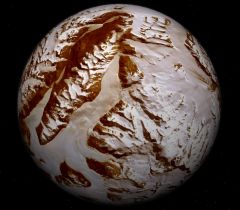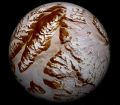Difference between revisions of "134340 Pluto"
(Corrected redirect tag.) Tag: New redirect |
(Added all content.) Tag: Removed redirect |
||
| Line 1: | Line 1: | ||
| − | + | {| cellpadding="2" cellspacing="0" style="margin:25px 0 0 10px; border:3px solid lightsteelblue;width:250px; font-size:90%; font-family:'Arial','Helvetica'; float: right; clear: right;"Pluto in Orbiter" | |
| + | !bgcolor="lightsteelblue" colspan="2" align="center" |Pluto | ||
| + | |- | ||
| + | |colspan="2" align="center"|[[Image:Pluto-PlutoCharonv20zip-Orbiter2005P1.jpg|Pluto|240px]] | ||
| + | |- | ||
| + | |colspan="2" align="center"|'''Pluto from ''Pluto-Charon_v2.0.zip'' in Orbiter 2005P1''' | ||
| + | |- | ||
| + | !bgcolor="lightsteelblue" colspan="2"|Designation | ||
| + | |- | ||
| + | |Name||align="right"|134340 Pluto | ||
| + | |- | ||
| + | |width="30%"|Reference body||align="right" width="30%"|Sun | ||
| + | |- | ||
| + | |width="30%"|Number of satellites||align="right" width="30%"|5 | ||
| + | |- | ||
| + | !bgcolor="lightsteelblue" colspan="2"|Planetary mean orbits | ||
| + | |- | ||
| + | |width="30%"|Epoch||align="right" width="50%"|J2000 (1 January 2000) | ||
| + | |- | ||
| + | |width="30%"|Semimajor axis (a)||align="right" width="50%"|5 906 376 270 000 m<br> (39.48168675 AU) | ||
| + | |- | ||
| + | |width="30%"|Eccentricity (e)||align="right" width="30%"|0.24880766 | ||
| + | |- | ||
| + | |width="30%"|Inclination (i)||align="right" width="30%"|17.14175017° <br> (0.29917998 radian) | ||
| + | |- | ||
| + | |width="30%"|Longitude of the ascending node (LAN, ☊)||align="right" width="30%"|110.3034701° <br> (1.92515873 radian) | ||
| + | |- | ||
| + | |width="30%"|Longitude of periapsis (ϖ)||align="right" width="30%"|224.0667602° <br> (3.91070271 radian) | ||
| + | |- | ||
| + | |width="30%"|Mean longitude (L)||align="right" width="30%"|238.9288099° <br> (4.17009441 radian) | ||
| + | |- | ||
| + | !bgcolor="lightsteelblue" colspan="2"|Selected physical parameters | ||
| + | |- | ||
| + | |width="30%"|Mean radius||align="right" width="30%"|1151000 m | ||
| + | |- | ||
| + | |width="30%"|Mass||align="right" width="30%"|1.5×10<sup>22</sup> kg | ||
| + | |- | ||
| + | |width="30%"|Sidereal rotation period||align="right" width="30%"|551808 sec (153.28 hours) | ||
| + | |- | ||
| + | |width="30%"|SidRotOffset||align="right" width="30%"|0 | ||
| + | |- | ||
| + | |width="30%"|Obliquity||align="right" width="30%"|68.69° (1.19886666 radian) | ||
| + | |- | ||
| + | |width="30%"|Note||align="right" width="30%"|*Elements given are from Pluto.cfg (pluto_pack.zip) | ||
| + | |} | ||
| + | |||
| + | '''Pluto (134340 Pluto)''' is a [[dwarf planet]] in the Kuiper Belt of the [[Solar System]]. It was disovered by [[w:Clyde Tombaugh|Clyde Tombaugh]] in February 1930. The dwarf planet is the ninth largest body that moves around the [[Sun]]. At first, Pluto was called a planet and is the largest body in the Kuiper belt. | ||
| + | |||
| + | Like other members of the Kuiper belt, Pluto is mainly made of rock and ice. It is quite small. It is about a fifth (⅕) of the weight of the [[Earth]]'s [[Moon]]. It is only a third (⅓) its volume. Pluto is very far from the Sun, so its temperature is very low. The average temperature on Pluto is -223 degrees Celsius. It has an [[w:orbital eccentricity|odd]] orbit and this orbit is very sloped. It takes Pluto to 30 to 49 [[Astronomical unit|AU]] (4.4–7.4 billion km) from the Sun. This causes Pluto to sometimes go closer to the Sun than [[Neptune]]. | ||
| + | |||
| + | At the time of its discovery, Pluto was considered a planet and was thought to be single body, but, in 1998 it was found to have a moon about half the radius of Pluto. In 2006, as part of the [[w:International Astronomical Union|International Astronomical Union (IAU)]] redefinition of planet and dwarf planet, henceforth, Pluto was reclassed as a dwarf planet. | ||
| + | |||
| + | Pluto's orbit is in a 3:2 resonance with that of [[Neptune]]. | ||
| + | |||
| + | == Pluto in Orbiter == | ||
| + | Pluto was first introduced with the release of ''pluto_pack.zip'' in July 2004. | ||
| + | |||
| + | {| class="wikitable" style="text-align: center" | ||
| + | |colspan="8"|<center>'''Orbiter versions and add-ons which include Pluto'''</center> | ||
| + | |- | ||
| + | !Add-on!!Source!!Version!!Author!!Type!!Release Date!!Compatibility!!Wiki article | ||
| + | |- | ||
| + | |[https://www.orbiter-forum.com/resources/pluto-charon-v2-0.230/ Pluto-Charon v2.0]||O-F Resources||2005-05-09||Nighthawke||Scenery||10 May 2005||Orbiter 2005|| | ||
| + | |- | ||
| + | |[https://library.avsim.net/esearch.php?DLID=&Name=&FileName=pluto_pack.zip&Author=&CatID=root Pluto Pack]||AVSIM||||CharlotMan||Scenery||17 July 2004|||| | ||
| + | |} | ||
| + | |||
| + | == Gallery == | ||
| + | <gallery> | ||
| + | Pluto-plutopackzip-Orbiter2003P2.jpg|<center>Pluto from ''pluto_pack.zip'' in Orbiter 2003P2</center> | ||
| + | Pluto-PlutoCharonv20zip-Orbiter2005P1.jpg|<center>Pluto from ''Pluto-Charon_v2.0.zip'' in Orbiter 2005P1</center> | ||
| + | Pluto in True Color - High-Res.png|<center>Image of Pluto by [[w:New Horzions|New Horizons]] spacecraft in July, 2015</center> | ||
| + | Animation of Pluto orbit.gif|<center>Animation of Pluto's orbit (magenta) as compared to the orbits of Saturn (yellow), Uranus (Cyan), Neptune (Blue)<br>from Wikimedia Commons</center> | ||
| + | </gallery> | ||
| + | |||
| + | ==References== | ||
| + | |||
| + | [[Category:Articles|Pluto]] | ||
| + | [[Category:Celestial bodies|Pluto]] | ||
| + | [[Category:Solar System|PLuto]] | ||
| + | [[Category:Dwarf planets|Pluto]] | ||
| + | [[Category:Trans-Neptunian objects|Pluto]] | ||
| + | |||
| + | {{PlutoMoons}} | ||
| + | {{SolarSystem}} | ||
Revision as of 11:35, 7 October 2024
Pluto (134340 Pluto) is a dwarf planet in the Kuiper Belt of the Solar System. It was disovered by Clyde Tombaugh in February 1930. The dwarf planet is the ninth largest body that moves around the Sun. At first, Pluto was called a planet and is the largest body in the Kuiper belt.
Like other members of the Kuiper belt, Pluto is mainly made of rock and ice. It is quite small. It is about a fifth (⅕) of the weight of the Earth's Moon. It is only a third (⅓) its volume. Pluto is very far from the Sun, so its temperature is very low. The average temperature on Pluto is -223 degrees Celsius. It has an odd orbit and this orbit is very sloped. It takes Pluto to 30 to 49 AU (4.4–7.4 billion km) from the Sun. This causes Pluto to sometimes go closer to the Sun than Neptune.
At the time of its discovery, Pluto was considered a planet and was thought to be single body, but, in 1998 it was found to have a moon about half the radius of Pluto. In 2006, as part of the International Astronomical Union (IAU) redefinition of planet and dwarf planet, henceforth, Pluto was reclassed as a dwarf planet.
Pluto's orbit is in a 3:2 resonance with that of Neptune.
Pluto in Orbiter
Pluto was first introduced with the release of pluto_pack.zip in July 2004.
| Add-on | Source | Version | Author | Type | Release Date | Compatibility | Wiki article |
|---|---|---|---|---|---|---|---|
| Pluto-Charon v2.0 | O-F Resources | 2005-05-09 | Nighthawke | Scenery | 10 May 2005 | Orbiter 2005 | |
| Pluto Pack | AVSIM | CharlotMan | Scenery | 17 July 2004 | |||
Gallery
Image of Pluto by New Horizons spacecraft in July, 2015
References
| edit Natural satellites of Pluto |
|---|
| edit The Solar System | |
|---|---|
| Central star |
Sun (Sol) |
| Planets |
Mercury - Venus - Earth - Mars - Jupiter - Saturn - Uranus - Neptune |
| Natural satellites |
Moon - Phobos - Deimos - Io - Europa - Ganymede - Titan - more... |
| Add-ons |
Planets - Dwarf Planets - Small objects - Natural satellites - Alternative star systems |




